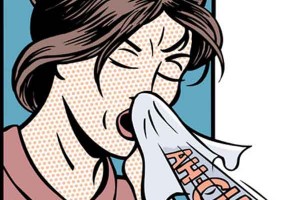I may get commissions for purchases made through links in this post.
 As I’m writing this I feel drowsy. Even after two big mugs of eye-popping strong coffee it’s impossible to concentrate.
As I’m writing this I feel drowsy. Even after two big mugs of eye-popping strong coffee it’s impossible to concentrate.
I hate getting up on dark cold winter mornings when my bed is still warm and cozy. It’s hard because I still feel tired when I wake up but there’s something worse.
During these winter mornings I keep feeling lethargic and hazy almost until lunch time. My body feels heavy like stone and my mind is foggy as London in fall.
I am not alone. More people struggle to get at ’em because they feel far from awake the first few hours past the alarm clock. The saying rise and shine does not apply to us.
What’s wrong with you?
Is what I asked myself. Maybe you did too. Perhaps these complaints sound familiar?
The sleepy feeling, that often occurs after waking from deep sleep, is called sleep inertia. The scientific definition; a transient period of lowered arousal after awakening.
It’s generally characterized by lack of energy, confusion, impaired cognitive or physical performance, and sleepiness. I myself feel very indecisive too.
Normally sleep inertia lasts a few minutes till half an hour. But because of dark winter mornings it lasts much longer in some people. (When I’m unlucky it endures the whole friggin day.)
The cause of the tenacious tiredness
Our 24 hour body clock, day-night cycle, our personal ebb and flow or whatever you want to call it is strongly influenced by daylight.
When it’s evening and gets dark our bodies start to produce melatonin. A hormone that makes us sleepy. Normally this is about two hours before bedtime (it varies per person and depends on your personal rhythm).
This process is called “dim light melatonin onset” (DLMO). And when the sun rises again melatonin production is stopped and we wake up.
During the dark winter mornings melatonin production goes on and it may take a while before its effects are worn off. In my case often until after noon. Hence my winter morning grogginess. There are, however, other factors into play. More in a bit.
How winter mornings can make you sad
During these days it’s as if my mind is still not awake. But I also feel disinterested and gloomy. Which has another cause.
When the sun rises something else happens in our body. Production of another hormone, serotonin, is stimulated. Among other things, serotonin regulates feelings of well-being. Which is why it is referred to as happiness hormone.
So when you wake up in the dark your body does not shift from melatonin to serotonin excretion.
In other words, darker mornings and evenings equal more melatonin and less serotonin, which result in some individuals in a disrupted and depressed feeling.
Wake-up lights, do they work?
This post is the result of my research on wake up lights. I had heard good things about them and wanted to know if they really work. If they can help me feel less of a grumpy hibernating bear that’s just been roused. But more importantly, if they can help me focus.
Shine and rise, with wake-up lights?
We all know that sunlight means energy. The fact that most ancient cultures worshipped the sun as a god still resembles how important sunlight is to us. We not only need it, we thrive on it. You are probably more active and fitter and happier in summer in too right?
The theory behind wake up lights is that exposure to the right kind of light can help us wake up and comfortably switch to our daily routine. But what exactly is that, the right kind of light? Various studies on which light is best to improve waking up have been done. In most of them participants were exposed to 250 lux light intensity.
The concept of dawn simulation was first patented in 1890. Also known as a “mechanical sunrise,” the technique involves timing lights in the bedroom to come on gradually, over a period of 30 minutes to 2 hours, before awakening.
The theory behind dawn simulation is that early morning light signals have a much greater effect on the body’s biological clock than light signals given at other times during a day. That’s why winter depression, aka seasonal affective disorder (SAD), patients also seem to benefit from wake up lights.
Based on these studies, wake-up lights, basically lights with alarm clock function, have been developed. They are capable of mimicking sunrise by slowly increasing the intensity or brightness of the light they emit.
Do wake up lights work?
They are known to help reduce this wintermorning sluggishness by waking people up as naturally as possible. I truly believe that for many people these units make a huge difference. You only have to glimpse at the raving reviews to know how satisfied most users are. There are just so much overwhelming positive responses.
On top of that, several studies show that the absence of morning light during winter days aggravates sleep inertia complaints. Studies on artifical dawn also demonstrate they work.
The use of the artificial dawn resulted in a significant reduction of sleep inertia complaints.
The strange thing about it though is that this is not because of a shift in the melatonin rhythm. In other words, they don’t seem to reduce melanin production in order to help you wake up. The main thing is that they seem to work.
However, initially, I was a little hesitant to order one.
Why I was wary of ordering a wake-up light..
Do I really need a dedicated wake-up-light? I mean, can’t I just set a programmable timer and have the big bedroom light switch on a half an hour before I have to get up?
The purpose being to stop melatonin production and stimulate serotonin? After all, I’m a snoozer. I’m happy to snooze at least a few times before getting up.
What’s the added benefit of such a light ? How does creating an artificial dawn aid my waking process more than having my bedroom lit a while before I have to wake up?
The reason for this hesitation is not that I’m too cheap to buy a wake-up-light.
If it really adds to my well-being and makes me feel more fit and even happier then by all means, I will order it yesterday. (I actually did, I ordered the Philips HF3520 yesterday because I’m fed up with feeling like I’m braindead most part of the day)
It’s more that I don’t like to have much possessions. I want to own as little stuff as possible and I hate to buy a product only to later on find out I could have achieved the same results with a simple household trick or hack. (I’m a sucker for cognitive dissonance.)
More importantly, I need to know that it works. And how it works.
What triggered my suspicion…
Several studies have been done on how artificial dawn stimulates and improves waking up. It seems like this research, as is so often the case, has been commissioned by manufacturers of wake-up lights. This does not necessarily have to mean we can’t trust the results.
However, in these studies a group of people were woken up with gradually increasing light whereas test groups woke up in the dark.
I was wondering why no studies compared dawn stimulation with wake up lights to a control group that woke up with non-gradual light. I would like to see a study that compared the use of a wake up light with a normal bed light that was turned on. (studies are mentioned at the bottom of this post).
I understand that a dedicated wake-up-light mimics sunrise far more realistically than described method. When I will just turn on the bedroom light I will miss out on the gradually getting brighter.
But this is not the main benefit, as I found out.
Why I now am convinced wake-up lights work
Each night we cycle through a few sleep stages. Some are lighter sleep, others are deeper. Stage 3 and 4 are the deepest stages of sleep known as slow-wave or delta sleep. (Contrary to what is often thought, REM sleep is not the deepest sleep phase.)
The purpose of the gradually increasing light intensity, mimicing a sunrise, is to bring you into a lighter phase of sleep.
This because if you wake up in a light stage of your sleep cycle you are not only easier to wake up but you will feel more rested, energetic, and bright. And this is what’s the real benefit of wake up lights as I understand:
The half hour of gradually increasing light intensity helps you enter a such a lighter sleep phase.
This has to do with the fact that in the early morning, our biological clock is sensitive to low intensity light. As studies demonstrate. So this is the key action, core benefit of wake up lights.
Researchers found that:
Dawn simulation units mimic the gradual twilight transitions found outdoors during spring and summer. These light signals are presented to people while they are still asleep, and while their eyes are still adapted to the dark of the night. This is the point where the circadian system is most susceptible to the phase advances of gradually brightening light. The presentation of diffuse, broad-field illumination evokes an antidepressant response and helps those affected by seasonal sleep disorders to wake up normally (Terman, M., & Terman, J.S., 2005)
Abrupt awakenings are reported to worsen sleep inertia complaints (Dinges, 1990; Dinges et al., 1981). A gradual way of waking up, induced by artificial dawn, could thus reduce sleep inertia complaints.
My Philips HF3520 wake-up light
Philips claim that 92% of wake-up light users find it helps them get out of bed in the morning. According to most people who use them the difference they experience is like night and day. Literally.
The Philips HF3520 uses a combination of natural light and sound to gently wake you up. The light starts from soft dawn red hues through warm orange flowing into bright yellow light 30-minutes before the alarm is set to ring.
My experiences so far. (This is an update, it’s now October 2014 and it’s the second year I’m using the wake up light)
- It really helps you wake up gently. No matter if it’s on a pitch-black morning or in the middle of the night. It’s hard to explain but it’s really smooth awakening. Most of the times the first thing I notice is that I feel the light through my eyelids and some sense of ‘it’s already a new day and the sun is shining’ comes to mind.
- You are literally in another state of being. Traditional alarm clocks made me hit the snooze button fall back into the deepest sleep over and over for a few times. Even after rinsing and repeating this procedure it was extremely difficult for me to rouse. Not with the wake up light. Even if I want to I’m not able to fall asleep anymore. Believe me I tried but something is different. I’m definitely more awake.
- Former models were huge (they used up all space on the average nightstand) but I like how this one is actually moderately sized and how it can be used as a bedside lamp.
- What I also really like is that you can set it to fade in a certain time when going to sleep. Light intensity can be adjusted in order to read by. It has a fall asleep mode, which simulates dusk. A time between 5 and 60 minutes can be set to let it fade out.
- Also great about this device is that you can wake up without an alarm sounding* which comes in handy if you are experimenting with polyphasic sleeping and don’t want to wake others on ungodly hours. (*provided that you wake up before the alarm goes off.)
- You can set different light intensities and several sounds such as birds tjirping, or FM radio.
- Read my review for a detailed write-up on my experieces with using a dawn simulator.
Who can benefit from solar simulators?
During workdays, in the early morning, late chronotypes (night owls), in particular, suffer from a combination of a nonoptimal circadian phase and sleep deprivation to help ease the wake-up process.
Wake up lights and other solar simulators are useful for
- People having a hard time waking up in the dark or during seasons with late morning sunshine.
- For working individuals who need to wake up at a specific time.
- For people suffering from seasonal affective disorder (SAD) and all the sleep and behavioral effects brought by changes in season or daylight hours.
- For those who suffer from sleep inertia or lack of energy and motivation upon waking up.
-
And for people who have existing health conditions where loud alarm clocks and abrupt methods of waking up are inappropriate.
Philips wake-up light alternatives
I’m pretty convinced that a dedicated wake-up light is a better solution for my complaints than a simple timer on my main light. If you want a more affordable way of simulating dawn, here are some other options. Do note that, as I learned when doing my research, the Philips is the only noteworthy device according to many reviewers.
- The Lighten Up! Model 308 Sunrise Simulator is basically a timer that you connect to your own lamp. Within 30 minutes it slowly turns up your lamp before it’s time to get up. At $40 it’s not that pricey. It’s small. You can use it to light up a room because it can handle up to 300 Watts. Downsides, timing needs to be set for each day of the week and it’s not entirely silent. Some people complain it has a “bit of a high-pitched whine”.
- The BioBrite SunRise Clock also offers slowly increasing light for a more gentle and peaceful transition to wakefulnessis. It is however reviewed less positive than the Philips light while it’s not that much more affordable.
- Some people say that you do not need a special light. They are convinced using a neodymium coated daylight bulb will do the job just as fine. I think they will miss out on the benefit of low intensity light influencing the circadian rhythm.
- The Lumen Smart Bulb may also be an option since it has a wake up mode. It has a light intensity of 400 lumen (equivalent of a 40W bulb). Not sure how that compares to the 250 lux of traditional wake up lights since lux is light quantity over an area and is hard to converse.
In Summary
Studies show that exposure to the proper amounts of early morning light is important for the correct function of the body’s internal clock.
Many people are susceptible to various seasonal conditions brought on by the changing light patterns as the length of daylight changes during different times of the year.
Some can be helped by using a wake-up light to simulate the gradually increasing light intensity following sunrise. Exposure to a dawn simulation light can help improve mood and cognitive performance after one wakes up.
Getting enough sleep stays crucial. In our busy modern times we tend to think we can do with less sleep but 7 to 8 hours is recommended for most people. However, various studies show this does not necessarily have to be in one block.
Depending on sleep timing and sleep phase upon awakening, sleep inertia may differ. However, it seems that the main factor influencing sleep inertia is the preceding amount of sleep (Achermann et al., 1995; Jewett et al., 1999).
Sleep-inertia severity is increased under sleep-deprivation conditions (Balkin & Badia, 1988; Dinges et al., 1985).
Next to quantity also sleep quality is important. Individual sleep needs differ from person to person because everyone has different cycles.
Therefore it’s recommended to find the right bed time and wake up time so you wake up coming out of a light sleep. But for some people this may not be enough. In that case an artifical dawn stimulator can be the solution.
Want to know how my experiences were? I kept a log on my experiences with my new wake-up light.
Studies on artificial dawn and wake-up lights
A number of studies have been conducted to examine the efficacy of using dawn simulation/wake-up lights.
- One analysis published in 2010 in Chronobiology International conducted two studies where users were subjected to artificial dawn lighting of different intensities; some prescribed by the study and others self-selected by the user. Both studies were shown to demonstrate that artificial dawn during the last 30 minutes of sleep is beneficial to those who experience sleep inertia.(Giménez, M.C.,Hessels, M., van de Werken, M., de Vries, B., Beersma, D.G., & Gordijn, M.C., 2010, July).
- Another study from 2010 in the Journal of Sleep Resolution also examined using artificial dawn to help dissipate sleep inertia in individuals. Sleep inertia was evaluated in individuals using sleep-electroencephalograms and by measuring body core and skin temperatures. The study utilized artificial dawn on some participants, while others used no light. The study concluded that people who suffer from sleep inertia can reduce their symptoms by exposing themselves to an artificial dawn signal (Van De Werken, M., Giménez, M.C., De Vries, B., Beersma, D.G., Van Someren, E.J., & Gordijn, M.C., 2010, September).
- A study from 2013 published in Chronobiology International used 17 patients who were exposed to different levels of light/dawn simulation and then were assessed for subjective sleepiness, mood, and well-being. The study concluded that exposure to an artificial morning dawn simulation light improves subjective well-being, mood, and cognitive performance (Gabel, V., Maire, M., Reichert, C.F., Chellappa, S.L, Schmidt, C., Hommes, V.,. . . Cajochen, C., 2013, October).
What do you think? Do you really need a more expensive wake-up light? Or does an automated timer on your bedroom light suffice? Weigh in below.
Image credit: Nory Chan
























Dear Kathryn
I am reaching out to you because I am doing a research on Wake up lights in the US. I work for The Business Research Company, which is conducting the research. Would you be willing to be interviewed for this project? The interview may be by phone for about 10-15 minutes. In return we would be happy to share the summary of the findings of our research with you.
Thanks
Mike
Phone number: +91 9700000710
Skype: michael.tbrc
Wake up light is a great product for early morning rise which does not cause panic to the person and wakes you up in a natural way.
Hi Thijs,
Thanks a lot for this review! I was persuaded by discounts on Amazon to buy the HF3520, it will arrive in 3 days, and I have been looking for honest reviews on it. Yours is the only one without any ads/quick buttons to buy the lamp, and by far the most academic. Thanks a lot for taking the time to review it! After a few months trying it out, I’ll come back here with a comment-review of my own. Happy holidays!
Thanks Marius. Looking forward to hearing about your experiences.
Hi Thijs,
So some time passed since my wake-up light arrived. Here’s, briefly, my experience:
OVERALL: The light works. I wake up with much less snoozing than before (sometime instantly, sometime I let it snooze once, and often I’d wake up before the bird sound). It’s definitely better than the cellphone alarm, and definitely worth the EUR 89 I paid.
POSITIVE: It’s great as a reading lamp too, and it has 20 “shades” of light that allows for a comfortable reading. It’s useful to also programme it to turn off after a certain amount of time, that way I wouldn’t be dragged in the book and forget I have work. Most importantly, it wakes you up relaxed and ready for the day, whereas before I used to be grumpy – maybe it’s because I used it in winter time, when I suspect the light’s effect is largest.
NEGATIVE: You have to position it at head-height level for it to work most effectively – for the first few weeks I had it on a bedtable twice as high as the bed, so the light didn’t reach my face directly. Also, if it’s not at maximum intensity, you might not notice it if you’re facing the wall when the birds start singing. The touch screen doesn’t always work as smoothly as a smartphone’s, but it works. Finally, it’s a pretty big device, make sure you have room on your bedside table.
I hope this helps. Overall, I recommend a wake-up light (Philips or any other Thijs mentioned), it’s a different experience, and worth it since 1/3 of our time is spent sleeping.
Thanks for sharing your experiences Marius. My wake up light is currently faced towards the wall (away from my bed) to avoid the glow of the display at night yet I still feel like the room is lit up by the morning sun when I wake up. The device is on the same height as my pillow though which, when it isn’t, I imagine could make a considerable difference. I might try it one of these days.
You can find lux to lumen calculators online if you know the approximate area the light is hitting.
The Phillips wake up lights are ~300 lumens. Smart bulbs are 400+ lumens do they are fine. The good wake up lights are also more blueish to wake you up more (cool vs warm light studies).
Smart bulbs even from Phillips can do all the things the clocks can do. I use the Phillips lux bulbs with a cell phone alarm.
Man.. I even detest just thinking about waking up early in the morning, groggy and all. I don’t understand there are people that wake up early in the morning with no problems. I would understand it if they only woke up in the summer on those times, that seems natural, but some people are just… well… aliens?
I think the base principles of those wake-up lights are sound. However, I do not think those wake-up lights do everything. Think about the wavelengths of light, only a small number are generated with those wake-up lights. The intensity of sunlight is also quite a few factors off.
When I’m sleeping in a cotton tent I tend to wake up feeling quite allright. There’s a lot of light coming through the cloth. A tent that’s not made of cotton will wake me up earlier, because it’s way too hot indoors.
So I’m thinking of modifying my wake-up light with a slave light that gives off lots of light in different wavelengths. I’m quite sure that will make a difference, compared to a standard wake-up light. I can’t think of any other physical factors compared to waking up in a tent.
Great read and collection of lights. A wake-up alarm clock could also be quite useful to anyone who sleeps with curtains or wakes up before the sun rises, regardless of the time of year.
Hopefully my product, https://HeyLark.com, will make the list sometime in the near future!
The Wake Up Light is a fantastic gadget for waking up early in the morning that does not generate fear and wakes you up naturally.